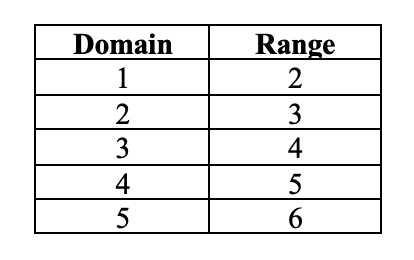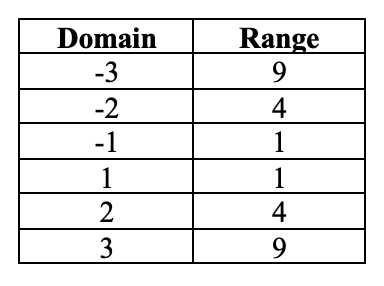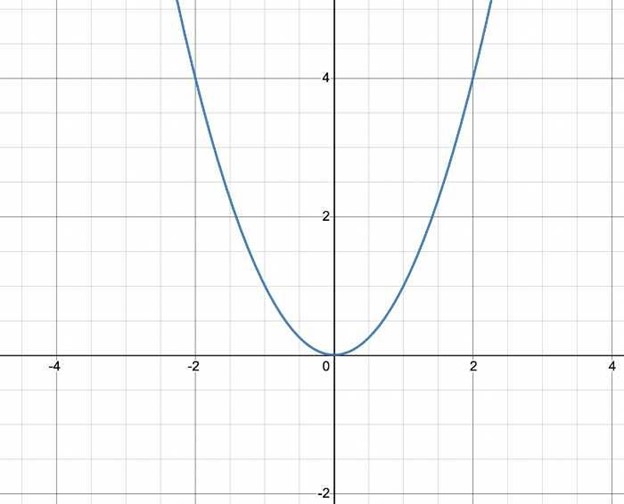One to One Functions - Graph, Examples | Horizontal Line Test
What is a One to One Function?
A one-to-one function is a mathematical function in which each input corresponds to only one output. So, for each x, there is just one y and vice versa. This implies that the graph of a one-to-one function will never intersect.
The input value in a one-to-one function is the domain of the function, and the output value is known as the range of the function.
Let's look at the examples below:

For f(x), any value in the left circle correlates to a unique value in the right circle. In the same manner, any value on the right corresponds to a unique value on the left side. In mathematical words, this implies every domain has a unique range, and every range owns a unique domain. Thus, this is a representation of a one-to-one function.
Here are some other examples of one-to-one functions:
-
f(x) = x + 1
-
f(x) = 2x
Now let's look at the second image, which exhibits the values for g(x).
Be aware of the fact that the inputs in the left circle (domain) do not own unique outputs in the right circle (range). Case in point, the inputs -2 and 2 have equal output, that is, 4. In conjunction, the inputs -4 and 4 have identical output, i.e., 16. We can comprehend that there are matching Y values for multiple X values. Thus, this is not a one-to-one function.
Here are additional examples of non one-to-one functions:
-
f(x) = x^2
-
f(x)=(x+2)^2
What are the properties of One to One Functions?
One-to-one functions have these characteristics:
-
The function owns an inverse.
-
The graph of the function is a line that does not intersect itself.
-
They pass the horizontal line test.
-
The graph of a function and its inverse are equivalent with respect to the line y = x.
How to Graph a One to One Function
To graph a one-to-one function, you are required to figure out the domain and range for the function. Let's examine an easy example of a function f(x) = x + 1.

Immediately after you have the domain and the range for the function, you need to plot the domain values on the X-axis and range values on the Y-axis.
How can you evaluate whether or not a Function is One to One?
To test if a function is one-to-one, we can apply the horizontal line test. Immediately after you plot the graph of a function, trace horizontal lines over the graph. If a horizontal line passes through the graph of the function at more than one place, then the function is not one-to-one.
Because the graph of every linear function is a straight line, and a horizontal line does not intersect the graph at more than one place, we can also reason that all linear functions are one-to-one functions. Don’t forget that we do not use the vertical line test for one-to-one functions.
Let's look at the graph for f(x) = x + 1. Once you graph the values to x-coordinates and y-coordinates, you need to examine whether a horizontal line intersects the graph at more than one point. In this instance, the graph does not intersect any horizontal line more than once. This indicates that the function is a one-to-one function.

On the contrary, if the function is not a one-to-one function, it will intersect the same horizontal line more than one time. Let's study the figure for the f(y) = y^2. Here are the domain and the range values for the function:

Here is the graph for the function:

In this example, the graph crosses numerous horizontal lines. For instance, for both domains -1 and 1, the range is 1. Additionally, for either -2 and 2, the range is 4. This implies that f(x) = x^2 is not a one-to-one function.
What is the opposite of a One-to-One Function?
Considering the fact that a one-to-one function has a single input value for each output value, the inverse of a one-to-one function also happens to be a one-to-one function. The inverse of the function basically undoes the function.
For Instance, in the event of f(x) = x + 1, we add 1 to each value of x for the purpose of getting the output, or y. The inverse of this function will deduct 1 from each value of y.
The inverse of the function is f−1.
What are the properties of the inverse of a One to One Function?
The properties of an inverse one-to-one function are no different than every other one-to-one functions. This signifies that the reverse of a one-to-one function will hold one domain for each range and pass the horizontal line test.
How do you determine the inverse of a One-to-One Function?
Finding the inverse of a function is very easy. You just need to change the x and y values. For example, the inverse of the function f(x) = x + 5 is f-1(x) = x - 5.

Considering what we learned before, the inverse of a one-to-one function reverses the function. Because the original output value required us to add 5 to each input value, the new output value will require us to delete 5 from each input value.
One to One Function Practice Examples
Consider the subsequent functions:
-
f(x) = x + 1
-
f(x) = 2x
-
f(x) = x2
-
f(x) = 3x - 2
-
f(x) = |x|
-
g(x) = 2x + 1
-
h(x) = x/2 - 1
-
j(x) = √x
-
k(x) = (x + 2)/(x - 2)
-
l(x) = 3√x
-
m(x) = 5 - x
For any of these functions:
1. Identify whether or not the function is one-to-one.
2. Chart the function and its inverse.
3. Figure out the inverse of the function mathematically.
4. Specify the domain and range of both the function and its inverse.
5. Apply the inverse to find the solution for x in each formula.
Grade Potential Can Help You Master You Functions
If you happen to be having problems trying to learn one-to-one functions or similar functions, Grade Potential can set you up with a private teacher who can support you. Our Fremont math tutors are skilled educators who assist students just like you improve their skills of these subjects.
With Grade Potential, you can study at your own pace from the convenience of your own home. Schedule a call with Grade Potential today by calling (510) 726-4360 to learn more about our educational services. One of our team members will contact you to better determine your requirements to provide you with the best tutor for you!




